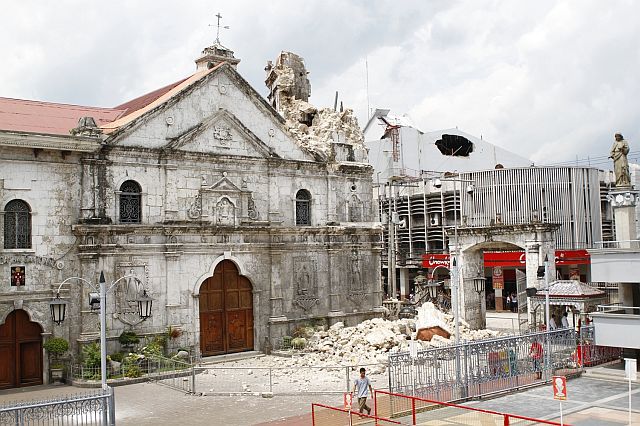Netizens: 7.2-magnitude quake in 2013 still fresh in our minds

The Basilica del Santo Niño bell tower was destroyed after a 7.2 magnitude earthquake hit the Visayas region last October 15, 2013. | CDN FILE PHOTO
CEBU CITY, Philippines — The scars of the 2013 Bohol earthquake that rocked the entire Central Visayas may have disappeared. But for some, the memories and ordeal of the tragedy remain fresh seven years later.
At precisely 8:12 a.m., a 7.2-magnitude earthquake struck Sagbayan town in Bohol last October 15, 2013, with tremors felt in nearby provinces, including Cebu, and as far as northern Mindanao.
One of the deadliest and strongest quakes recorded in recent history of the Philippines, experts believe the energy of the quake is equivalent to 32 atomic bombs that were dropped onto Hiroshima in Japan during World War II. The nuclear bomb dropped over Hiroshima, Japan, on Aug. 6, 1945, packed power equal to 20,000 tons of TNT.
RELATED STORY: Bohol quake ‘like 32 Hiroshima bombs’
Netizen Ariana Barry shared with CDN Digital what she went through when the ground beneath her feet started shaking violently.
“What a shocking experience way back seven years ago. That time, nagbuhat ko ug toast for breaky (colloquial term for breakfast). Sa kahadlok, ni karatil ko ug dagan while ga on ang oven (I was making toast for breakfast. Frightened, I frantically ran out of the house, leaving the oven still turned on),” said Barry.
Facebook user Chai Densing Sentillas also remembered how the earthquake greeted her that morning while she was within the vicinity of Marcelo Fernan Bridge that connects Mandaue City and Lapu-Lapu City.
“Presko pa kau sa akong panumdoman ang nahitabo.. Naa jd ni sa tiilan sa Marcelo Fernan bridge pag shake,” said Sentillas.
(The incident is still fresh in my memory..We were at the foot of the Marcelo Fernan Bridge when it started to shake.)
Twitter user @itsthefrey also shared how he and his co-workers rushed to find safer grounds while they were out on a field.
“We were on the field, then suddenly the ground shook. We stopped under an effen coconut tree. Went to an open field waiting for the aftershocks to finish. A few hours later, we were on a rocky slopy mountain then it shook again. And we hid behind trees,” he stated.
In the aftermath of the 2013 Bohol Earthquake, at least 222 lives were lost, close to 1,000 more were left injured, and hundreds of properties, including heritage sites such as churches, built way back during the era of Spanish colonization, were either totally or partially damaged.
In Cebu, several notable buildings, such as the Marcelo Fernan Hall of Justice within the Capitol compound and the controversial Cebu International Convention Center (CICC) in Mandaue City, were condemned after suffering major damages due to the quake.
Dozens of aftershocks were also logged even a couple of days after the earthquake struck. By the first week of December 2013, the Philippine Institute of Volcanology and Seismology (Phivolcs) recorded over a total of 4,000 aftershocks, of which 114 were felt.
/bmjo
Disclaimer: The comments uploaded on this site do not necessarily represent or reflect the views of management and owner of Cebudailynews. We reserve the right to exclude comments that we deem to be inconsistent with our editorial standards.
